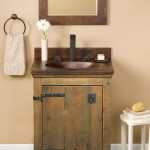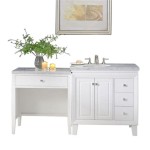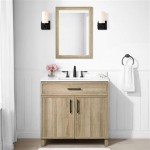Can You Use Large Tiles In Small Bathrooms? Exploring the Possibilities
The question of whether large format tiles are suitable for small bathrooms is a common one in interior design and renovation projects. While conventional wisdom might suggest smaller tiles for smaller spaces, the strategic application of large tiles can, in fact, enhance the perceived size and overall aesthetic of a small bathroom. This article explores the advantages, disadvantages, and key considerations when using large format tiles in compact bathroom spaces.
The term "large format tile" typically applies to tiles that are significantly larger than standard sizes. While specific dimensions vary depending on the manufacturer and regional definitions, tiles exceeding 12 inches by 24 inches are generally categorized as large format. Some formats can even reach sizes of 24 inches by 48 inches or larger. Their increasing popularity stems from their ability to create a seamless and visually expansive surface. The fewer grout lines inherent in their application contribute to this effect.
Choosing the right tile size for a bathroom requires careful consideration of several factors. These include the bathroom's dimensions, layout, natural light availability, and the desired style. Incorrectly sized tiles can make a small bathroom feel even smaller or appear disproportionate. Therefore, a thorough understanding of the pros and cons of large tiles in constrained spaces is essential before making a decision.
Advantages of Using Large Tiles in Small Bathrooms
Several compelling reasons support the use of large format tiles in small bathrooms. These benefits primarily relate to visual perception, ease of maintenance, and modern aesthetics.
Firstly, large tiles minimize grout lines. Grout lines, being interruptions in the tile surface, can create a busy and fragmented look, especially in small spaces. By reducing the number of grout lines, large tiles create a more continuous and less cluttered surface. This uninterrupted visual flow can make the bathroom appear larger and more spacious. The eye perceives a more cohesive plane, leading to an illusion of greater size.
Secondly, large tiles often simplify cleaning and maintenance. With fewer grout lines, there are fewer areas where dirt, grime, and mold can accumulate. Grout is a porous material that is susceptible to staining and discoloration. Reducing the grout area minimizes the potential for these issues, making cleaning faster and more effective. This benefit is particularly valuable in bathrooms, which are prone to moisture and humidity.
Thirdly, large format tiles can contribute to a more modern and sophisticated aesthetic. Their clean lines and expansive surface create a contemporary look that can elevate the overall design of the bathroom. The sleek appearance of large tiles can transform a small, dated bathroom into a stylish and inviting space. They are available in a wide range of materials, colors, and textures, allowing for diverse design possibilities from minimalist to luxurious.
Furthermore, the illusion of spaciousness is further enhanced when large tiles are installed in a way that minimizes cuts. Careful planning and strategic layout can reduce the need for small, awkward tile pieces, which can disrupt the visual flow. Using the same large tiles on both the floor and walls can also contribute to a more unified and expansive look.
Disadvantages and Challenges of Using Large Tiles in Small Bathrooms
Despite the advantages, several challenges must be addressed when using large tiles in small bathrooms. These relate to installation complexities, potential for waste, and cost considerations.
Installation can be more complex and require professional expertise. Large format tiles are heavier and more difficult to handle than smaller tiles. They require a perfectly level and structurally sound substrate to prevent cracking or unevenness. The larger size also demands precise cutting and alignment, particularly around fixtures and corners. A skilled tile setter with experience in large format installations is crucial for achieving a flawless and durable result. The use of specialized tools, such as suction cups and leveling systems, is often necessary.
Waste management can increase because of the need for cuts. In small bathrooms with irregular shapes or numerous fixtures, a significant amount of tile may need to be cut to fit. This can lead to increased material waste and higher overall project costs. Careful planning and measurement are essential to minimize waste. Considering the layout of fixtures and potential tile patterns before purchasing tiles can help reduce unnecessary cuts. It's advisable to order slightly more tile than calculated to account for potential breakage or cutting errors.
Cost implications must be considered. While the per-tile cost of large format tiles may not always be higher than that of smaller tiles, the increased complexity of installation can significantly increase labor costs. The need for specialized tools and experienced installers contributes to the higher overall project expense. Additionally, the potential for increased waste can also impact the budget. It's important to obtain detailed quotes from multiple contractors and compare the total project costs, including materials, labor, and any necessary substrate preparation.
Another potential challenge is maintaining proper slope for drainage, especially in shower areas. Achieving the necessary slope with large tiles can be more difficult than with smaller tiles, requiring careful planning and precise installation. Improper drainage can lead to water pooling and potential mold growth. The tile setter must be experienced in creating the correct slope while maintaining a level and aesthetically pleasing surface.
Key Considerations for Successful Large Tile Installation
To successfully incorporate large format tiles in a small bathroom, several key considerations must be addressed. These involve careful planning, material selection, and professional installation.
First, plan the layout meticulously. Before purchasing tiles, create a detailed layout plan that takes into account the dimensions of the bathroom, the placement of fixtures, and the desired tile pattern. Identify potential problem areas, such as corners and areas around plumbing fixtures. Consider using a professional design software or consulting with an interior designer to create a comprehensive plan that minimizes cuts and maximizes visual impact. Determine the starting point for tile installation to ensure a balanced and symmetrical appearance.
Second, select the appropriate tile material and finish. The type of tile material and finish can significantly impact the overall aesthetic and functionality of the bathroom. Porcelain tiles are a popular choice for bathrooms due to their durability, water resistance, and wide range of available styles. Natural stone tiles, such as marble or granite, can add a touch of luxury, but they require more maintenance. The tile finish should also be carefully considered. Matte finishes offer better slip resistance, while glossy finishes can reflect light and make the bathroom appear brighter. However, glossy finishes may be more slippery when wet. The texture of the tile can also play a role in slip resistance and overall aesthetic.
Third, hire a qualified and experienced tile installer. The success of a large tile installation hinges on the expertise of the tile installer. Look for a contractor with extensive experience in large format tile installations and a solid reputation for quality workmanship. Ask for references and review their portfolio to assess their skills and attention to detail. A skilled installer will be able to properly prepare the substrate, accurately cut and align the tiles, and create a flawless and durable finish. They will also be knowledgeable about the necessary tools and techniques for working with large format tiles.
Furthermore, consider the use of light-colored tiles to enhance the feeling of spaciousness. Light colors reflect light and make a room appear larger. Neutral tones, such as white, beige, and light gray, are excellent choices for small bathrooms. These colors create a clean and airy atmosphere that can help to visually expand the space. Avoid dark colors, which can absorb light and make the bathroom feel smaller and more enclosed. Complement the light-colored tiles with light-colored grout to further minimize visual interruptions.
Finally, pay attention to the grout color and width. Choosing a grout color that closely matches the tile color can further minimize the appearance of grout lines and create a more seamless surface. Narrow grout lines are also preferable for large format tiles, as they reduce the visual impact of the grout. Epoxy grout is a good option for bathrooms due to its water resistance and stain resistance. It is also easier to clean than traditional cement-based grout.

Big Tile Or Little How To Design For Small Bathrooms And Living Spaces S Of America

Tiles Talk Find The Right Size For A Small Bathroom

Big Tile Or Little How To Design For Small Bathrooms And Living Spaces S Of America

How To Make A Small Bathroom Look Bigger With Tiles Roccia

Choosing Tiles For A Small Bathroom Tile Wizards

Big Tile Or Little How To Design For Small Bathrooms And Living Spaces S Of America

19 Tricks To Make A Small Bathroom Look Bigger First Choice Warehouse

10 Tile Ideas For Small Bathrooms And Cloakrooms Tiling Advice

Big Tile Or Little How To Design For Small Bathrooms And Living Spaces S Of America

Big Design Ideas For Small Bathrooms
Related Posts







